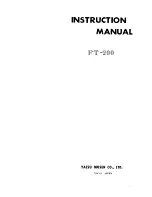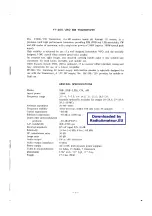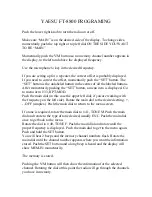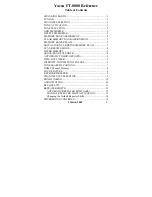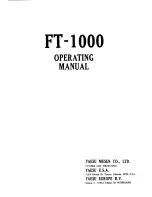
www.javad.com
15
to ten minutes. The REC LED will be yellow.
• Check the SAT light for satellites tracked.
•
When finished, press the FN button for less than 1
second to assign the Rover to kinematic.
• Move the Rover to the next location (survey point),
and press the FN button for less than a second to col-
lect the data in static mode for two to ten minutes.
•
Repeat steps five and six until all points have been
surveyed. The occupation time for the points de-
pends on the same factors as for the static survey
method.
•
When finished, press the FN button for one to five
seconds to stop logging data. Turn off the Rover if
needed. This method of GNSS survey allows the
operator to reduce the point occupation time, thus
permitting field crews to survey many more points
compared to the other methods available.
Real Time Kinematic Surveying
With RTK surveying, as with kinematic surveying
described above, one receiver serves as the reference
station and conducts observations with its antenna af-
fixed to a stationary tripod or some other device. The
other receiver functions as a rover and conducts obser-
vations (using an antenna) affixed to a mobile pole and
moved to observation points.
Unlike post-processed kinematic surveys, RTK sur-
veys utilize a communications link between the Base
and Rover. Using a radio modem link, the Base receiv-
er transmits its measurement and location data to the
Rover receiver. The Rover, based on the transmitted
data and its own observation data, immediately con-
ducts a baseline analysis and outputs the results.
Usually, the receiver will start to output the coordi-
nates of the antenna’s phase center along with the solu-
tion type within 10–30 seconds. However, UHF radios
and GSM phones may take as long as 60 seconds to
synchronize. The geodetic coordinates displayed on the
Location tab are always computed in WGS84 and have
four solution types.
• Standalone – where the receiver computes 3D co-
ordinates in autonomous mode without using differ-
ential corrections.
• Code differential – where the Rover receiver com-
putes the current relative coordinate in differential
mode using only pseudo ranges.
•
RTK float – where the Rover receiver computes
the current relative coordinates in differential mode
using both pseudo ranges and phases; however, with
a float solution, the phase ambiguity is not a fixed
integer number and the “float” estimate is used in
-
stead.
•
RTK fixed – where the Rover receiver computes
current relative coordinates, with ambiguity fixing,
in differential mode. The LQ field reflects the status
of the received differential messages and contains
the following information:
• Data link quality in percentage
• Time (in seconds) elapsed since the last re-
ceived message
• Total number of received correct messages (de-
pendent on the message type received)
• Total number of received corrupt messages (de-
pendent on the message type received)
• If the receiver is not (for some reason) receiv-
ing differential corrections, or if none of the ports
has been configured to receive differential correc
-
tions, the LQ field will either be empty or it will
look like this: 100%(999,0000,0000).
Receiver and File Maintenance
If post-processing the data after completing a mea-
suring, the data in the receiver’s memory will need to
be downloaded to a computer. Downloading and delet-
ing files will also prepare the receiver’s memory for the
next measuring. Occasionally, the receiver’s NVRAM
may need to be cleared to eliminate communication
or tracking problems. As project expectations expand,
the receiver’s OAF may need to be updated to provide
expanded operation and functionality. The receiver
requires firmware to properly operate and provide ap
-
propriate functionality. As JAVAD GNSS releases firm
-
ware updates, loading these updates into the receiver
will ensure that the receiver operates at its full potential.
Deleting Files and Downloading Files to a
Computer
When your measuring finishes, you can down
-
load your measuring files to a computer for storage,
post-processing, or backup. Also, the DELTA memory
holds a finite amount of files and information, so down
-
loading the files to a computer ensures that no files are
lost. You should download files as soon as possible af
-
ter collecting data at the jobsite. NetView provides a
File Manager to download files to your computer and
delete files from the receiver DELTA.
























